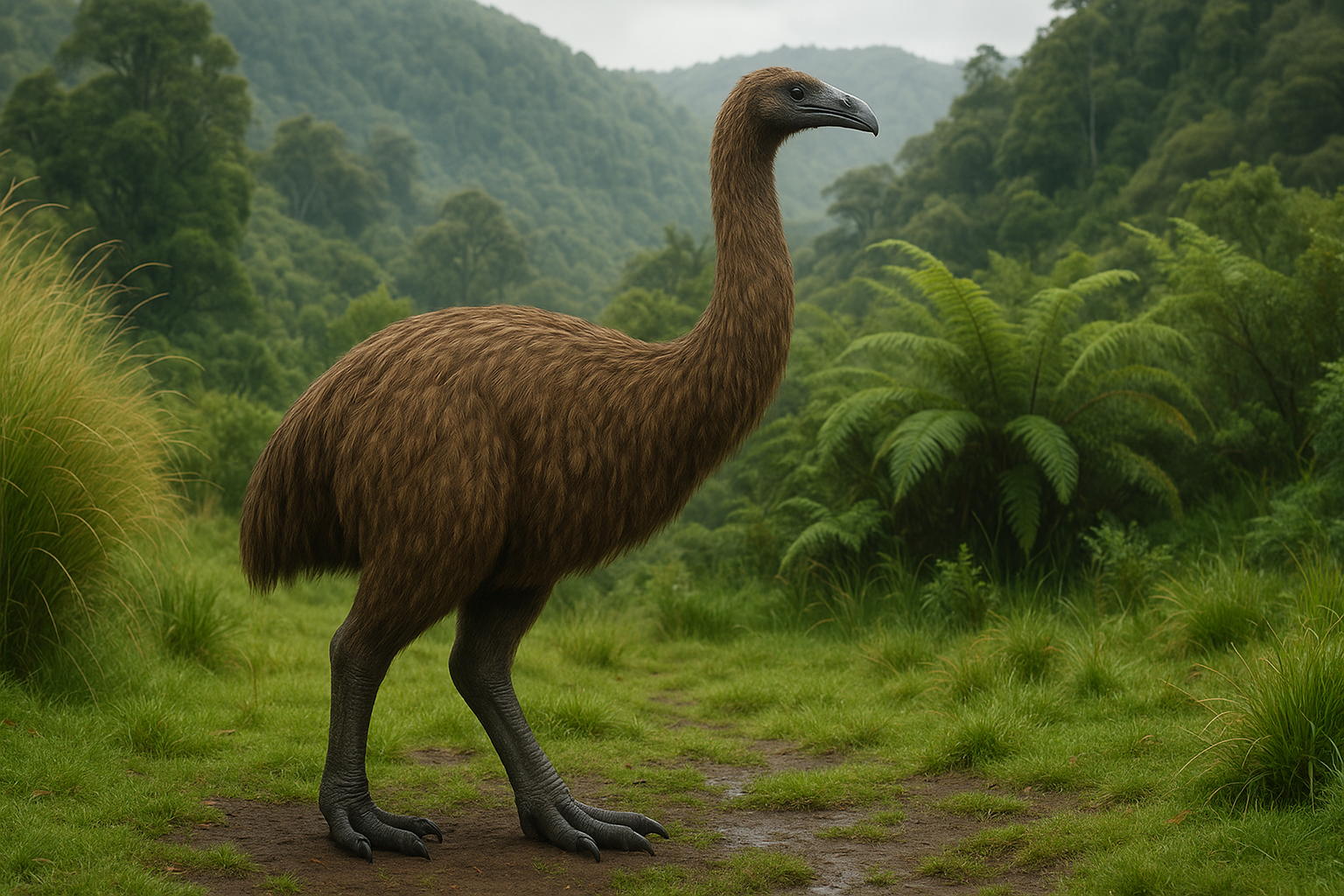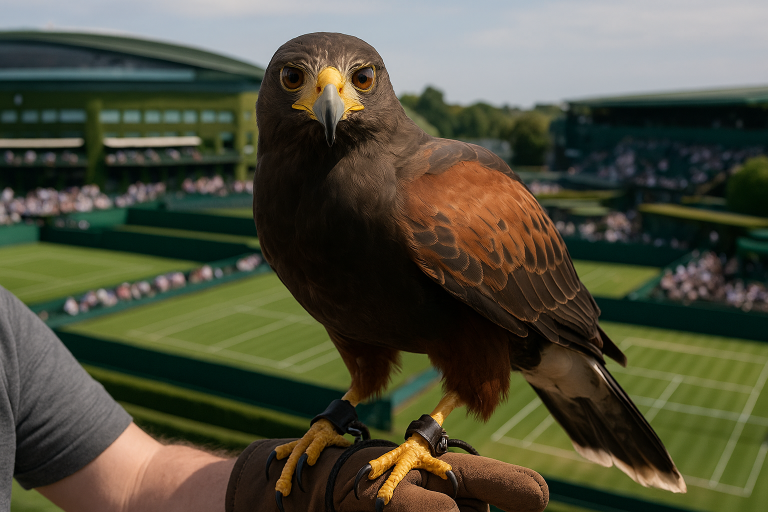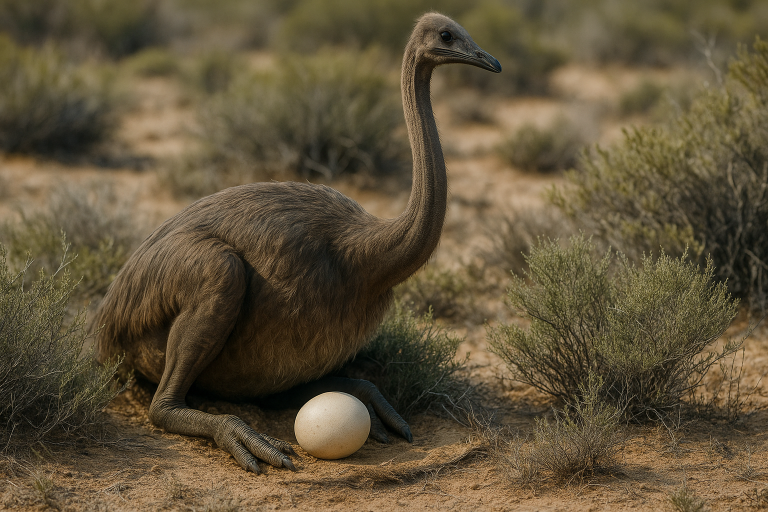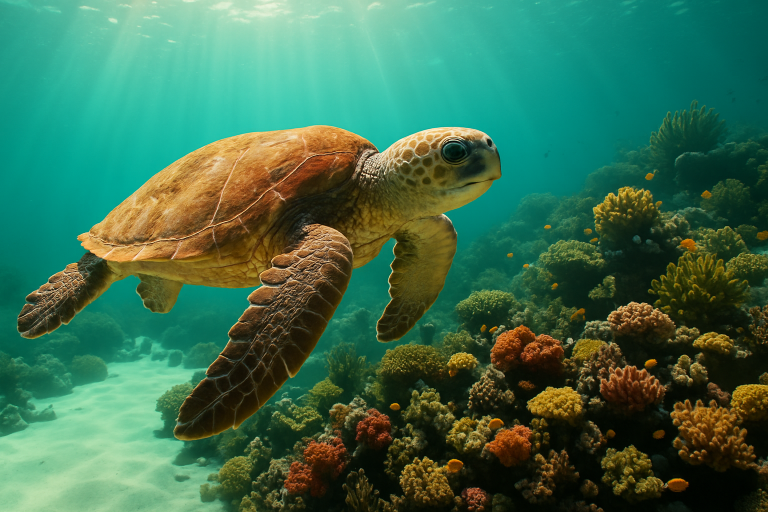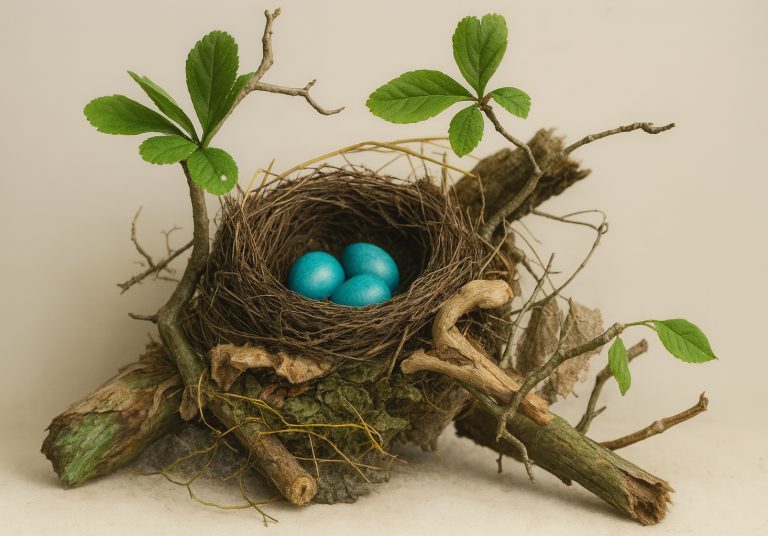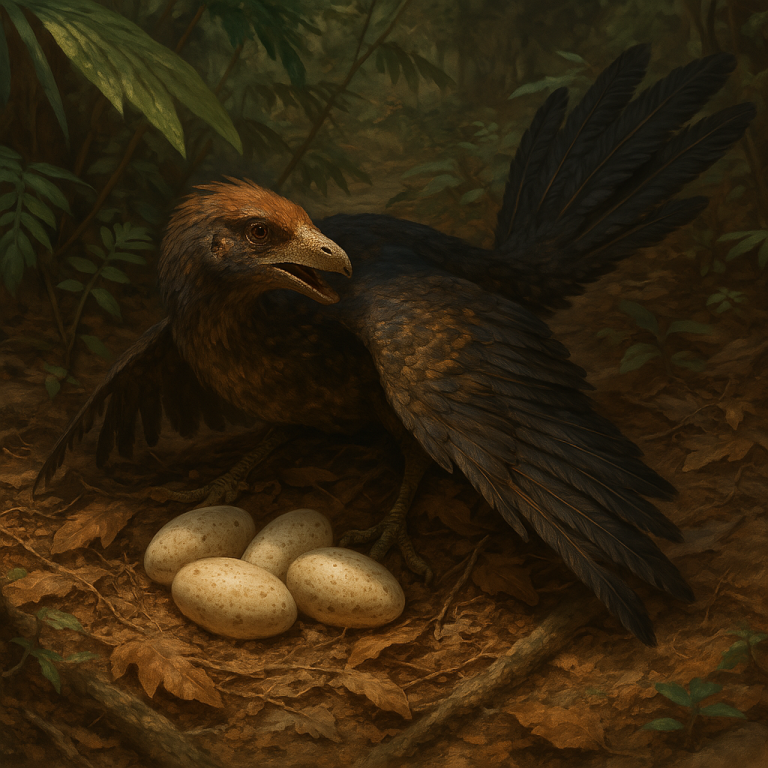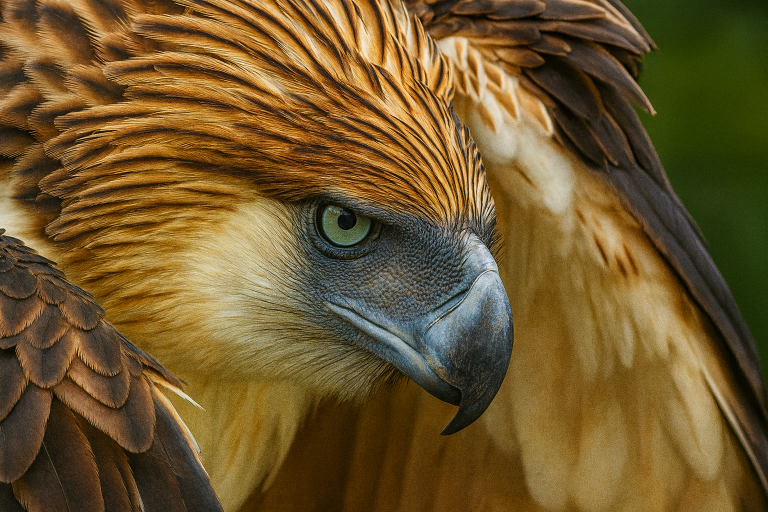The Extraordinary Moa and its Eggs
In the late 1850s, a workman digging foundations at Kaikōura on New Zealand’s South Island made a startling discovery of a gigantic egg buried beside an ancient human skeleton. The egg measured about 24 cm long and nearly 18 cm wide. Big enough to dwarf an ostrich’s egg and make an emu’s look puny. It likely weighed around 4 kg when fresh, holding the volume of dozens of chicken eggs. Māori villagers centuries ago had hollowed it out through a small drilled hole, perhaps using it as a water vessel before interring it as a precious grave offering. This “Kaikōura egg,” the largest moa egg ever found, offered the first tangible link to the moa; the giant, flightless birds that had vanished from New Zealand hundreds of years earlier. It was a fragile time capsule from a lost world, and it sparked scientific and public fascination that continues to this day.
The Biology of Moa Eggs
Moa eggs are as remarkable as the birds that laid them. Only a few dozen more-or-less intact moa eggs have ever been recovered, from sites scattered across New Zealand. These eggs vary enormously in size and shape, reflecting the range of moa species. The smallest known moa egg is about 12 cm long and 9 cm wide, roughly the size of an emu’s egg, and was likely laid by a smaller species like the coastal moa Euryapteryx. The largest, like the Kaikōura specimen, measures 24 × 17.8 cm and was probably laid by the giant south island moa (Dinornis robustus), a bird that stood over 2 m tall. In general, moa eggs were ellipsoidal in shape with one end slightly narrower, much like the eggs of ostriches or emus. Yet even the biggest moa egg was relatively small compared to the bird’s colossal body size, especially when contrasted with the kiwi, a smaller bird that lays an enormous egg relative to its body.
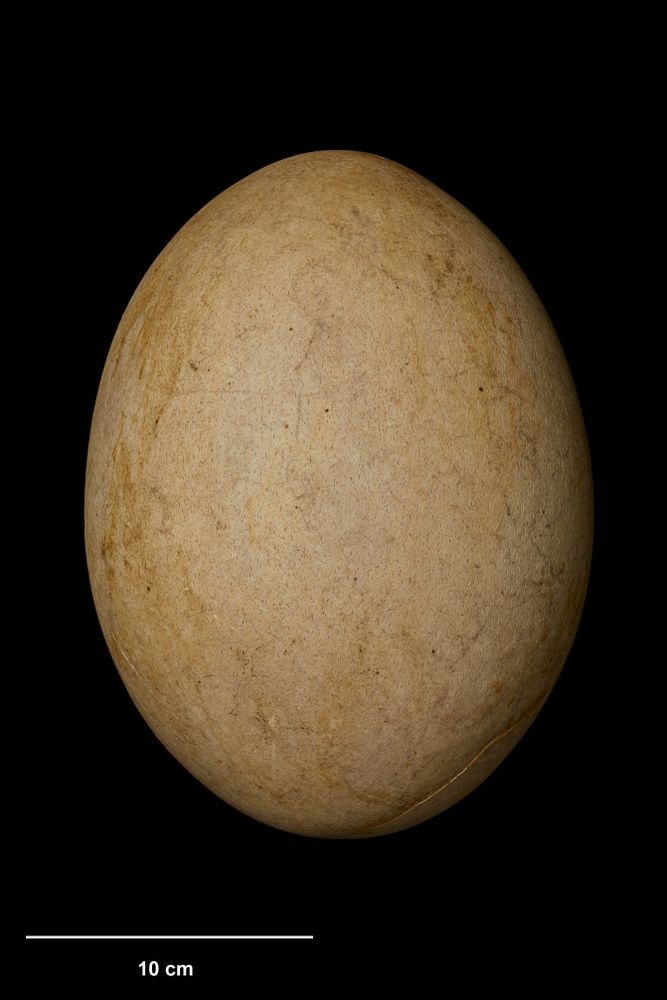
Despite their size, moa eggshells were surprisingly thin and delicate. Shell thickness ranges from only about 1.0 to 1.4 mm. Even the largest eggs had shells barely 1.2–1.3 mm thick – far thinner than one would expect for such giant birds. By comparison, an ostrich eggshell is ~2 mm thick, and the elephant bird of Madagascar laid truly gargantuan eggs with 4 mm thick shells. The outer surface of moa eggshell is marked by small pores, a microstructure trait that aided gas exchange for the developing embryo. Most moa eggshell fragments found are a plain whitish or ivory color, indicating that most moa species laid white eggs. However, a few eggshells have a pale greenish-blue tint, notably those attributed to the upland moa (Megalapteryx didinus), suggesting that at least this high-country species laid colored eggs. The combination of thin shells and large size meant moa eggs were extremely fragile. In fact, a genetic and structural analysis in 2010 showed these were “the most fragile of all avian eggs measured to date,” despite some being 80 times the volume of a chicken egg. The fragility is astounding. One research team noted that the heaviest moa (the giant Dinornis and its kin) produced eggs more prone to breakage than any of the 3,400+ bird species studied so far.
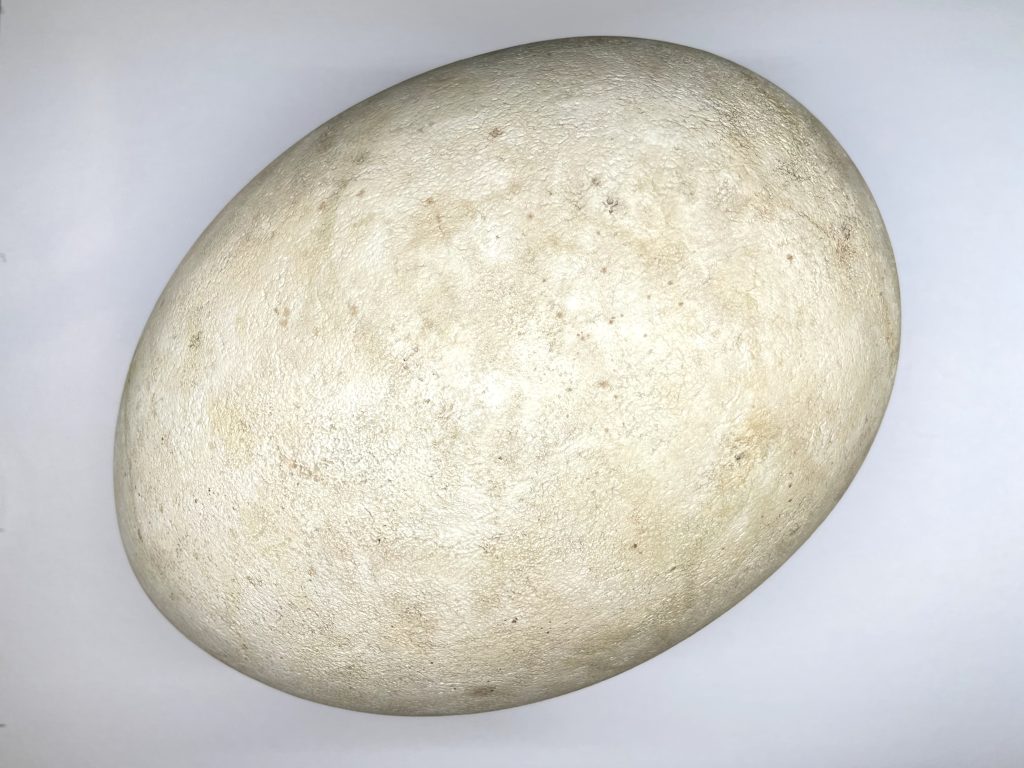
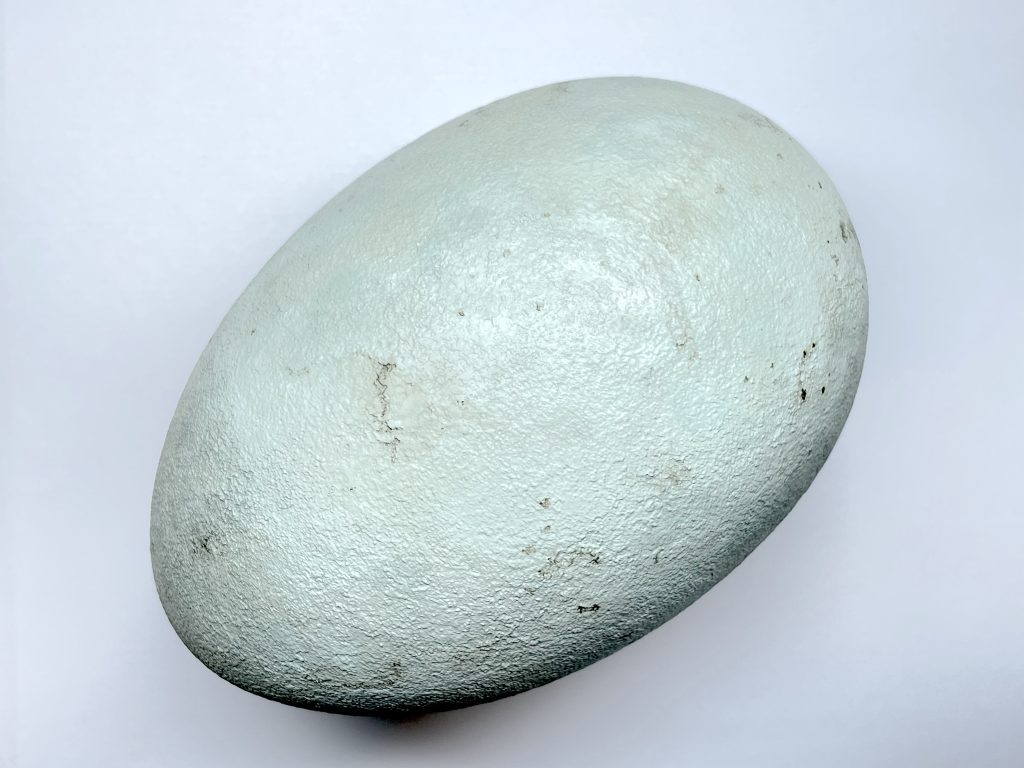
Unearthing Ancient Moa Eggs
Finding an intact moa egg is exceptionally rare. Much more often, scientists and collectors must content themselves with eggshell fragments, which are relatively common in the fossil record. Moa eggshell pieces turn up in rock shelters, caves, dunes and middens (ancient refuse heaps) all over New Zealand. Early Māori hunters often left shards of eggshell in coastal sand dunes alongside the bones of butchered moa, indicating that eggs were sometimes collected and eaten or repurposed. Natural accumulations of eggshell also occur where moa nests once existed, such as in dry sheltered caves.
In the late 19th and early 20th centuries, eggs submerged in sand and soil began coming to light often by pure chance. In 1899 a gold dredge operator on the Clutha River noticed a pale oval object bobbing up from the flood-scoured riverbank. It turned out to be a near-perfect moa egg, freed from its muddy grave by the river’s rush. The local museum paid the dredge-hand £50 – a hefty reward at the time – in exchange for this treasure, which promptly went on display. In 1911, a young rabbiter checking his traps in Central Otago stumbled upon another great egg exposed by a recent landslide on a river terrace. And in 1931, workmen excavating a cliff at Waitotara (Whanganui region) suddenly found themselves face-to-face with a completely intact moa egg sealed in the earth.
News of moa egg discoveries traveled fast, and museums rushed to acquire these rare pieces of natural history. By the late 1800s, the world had learned of the moa’s demise, and anything related to these giant birds was considered scientifically invaluable as well as publicly captivating. Intact eggs in particular became prized curiosities. Naturalists hoped to study them for clues to the moa’s biology, while museums knew that such spectacular finds would draw crowds. In several cases, eggs unearthed in New Zealand were quickly purchased or donated to museums, ensuring they would be preserved intact. Four of the best-preserved moa eggs eventually made their way to Britain’s Natural History Museum in London, reflecting an international fascination with these lost bird.
Within New Zealand, regional museums and private collectors likewise vied for moa eggs as crown jewels of their collections. When the Clutha River egg surfaced in 1899, Otago Museum wasted no time in securing it for displayn. In another instance, a farmer in Northland who found a small moa egg around 1900 kept it on his mantelpiece for 30 years as a family curio until a visiting curator impressed upon him its scientific importance, and he gladly presented it to a museum for posterity. Even the very first moa egg found (the Kaikōura grave egg) was exhibited to the public as early as 1865, and later traveled to London for a colonial exhibition. A century later, in 1966, that same egg was finally brought home and purchased for New Zealand’s national collection, recognized as a treasure that belonged on its native soil.
In the mid-20th century, archaeologists excavating rock shelters in the North Island uncovered actual moa nesting sites, recognizable as shallow scrapes in the ground in soft soil or pumice. In Central Otago (South Island), the arid climate preserved delicate nesting materials. Researchers have found twigs, leaves, and strips of bark that adult moa gathered to line their nests, still left in place after centuries. Among this dried vegetation were moa droppings containing seeds and pollen, which provided a clue that moa nesting season occurred in late spring to summer. These rare finds give us a direct glimpse of how and where moas incubated their eggs.
To study moa eggs, scientists have employed a toolkit of methods. Early naturalists measured the curvature of large eggshell fragments to estimate the full egg size and even tried to match shell fragments with particular moa species based on eggshell thickness and region. Under the microscope, moa eggshell shows the crystalline layering typical of ratites (flightless birds) but also unique patterns that helped confirm their identity in the 19th century. In modern times, one of the most powerful tools has been ancient DNA analysis. Moa eggshells, even when broken, often preserve DNA from both the embryo (on the shell’s inner surface) and the incubating parent (on the outer surface). In 2010, a landmark study extracted DNA from eggshells of seven different moa species, definitively identifying which species laid which eggs and revealing aspects of their reproduction. This genetic sleuthing solved longstanding puzzles – for instance, it proved that some very large eggs with ultra-thin shells belonged to the giant moa, not a smaller bird. Ancient DNA techniques have been so successful that enough genetic material has been recovered from fossil eggs to reconstruct the moa’s entire genome in recent years. Each discovery, whether a lone egg fragment in a sand dune or a perfectly preserved whole egg in a museum drawer, adds a piece to the puzzle of how these giant birds lived and bred.
Moa Eggs in Māori Culture and Myth
To the indigenous Māori, who arrived in New Zealand around the 13th century, moas were taonga (treasured resources) and their eggs were no exception. Archaeological evidence shows that early Māori collected moa eggs. At least a dozen known eggs have been found in Māori middens and burial sites, indicating they were used during the initial centuries of Polynesian settlement. Some eggshells in middens bear scorch marks or cracks consistent with cooking, implying that these huge eggs supplemented the diet alongside moa meat. Ethnographic accounts and artifacts also suggest that empty eggs were used as containers, much like ostrich eggs in Africa. In Māori tradition, a fresh moa egg could be drained by drilling a small hole, then the tough but lightweight shell would serve as a flask to carry water. The Kaikōura egg exemplifies this practice. Its tapered end was carefully perforated, and it was found deliberately placed next to a human skeleton, likely as a funerary offering. The presence of a moa egg in a grave hints at its spiritual or symbolic value, perhaps as a symbol of sustenance for the afterlife, or simply as a highly prized object bestowed upon the deceased.
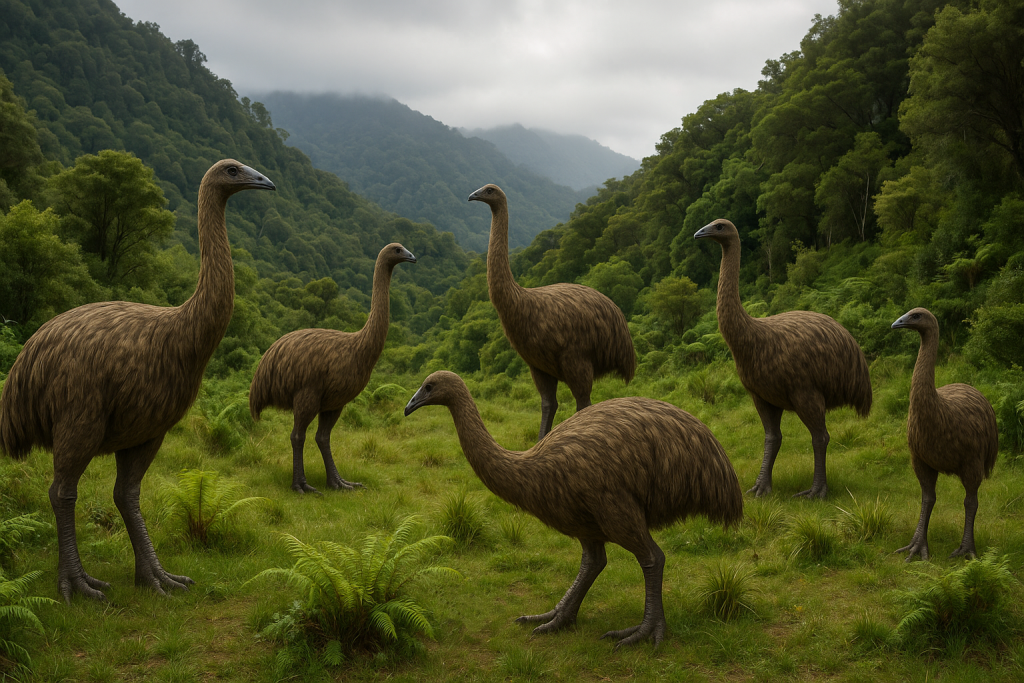
Moa themselves loom large in Māori oral tradition and mythology. The very name “moa” comes from Polynesian language meaning domestic fowl. It hints at how the first settlers viewed these unfamiliar giant birds. Over generations, moas were woven into legends. In some South Island dialects, the giant Haast’s eagle that preyed on moa was remembered as Pouākai, a monstrous bird of lore, showing how awe-inspiring the moa’s world was to early people. Even after moas died out, they lived on in whakataukī (proverbs) and metaphors. For example, one proverb lamented “Kua ngaro i te ngaro o te moa” – “Lost as the moa was lost,” using the moa’s extinction as a cautionary symbol of irretrievable loss. Other sayings mention cooking moa with certain wood, underscoring that knowledge of how to hunt and prepare these birds persisted in memory. In Māori culture, the moa came to embody both abundance and fragility; huge birds that provided food, feathers, and bone, yet were quickly overexploited. Their eggs, similarly, could feed many but could also be destroyed with a single careless touch. The cultural impact of the moa’s disappearance was profound. Some later Māori narratives even use the loss of the moa as a parallel for the potential loss of the Māori people themselves. In short, moa eggs were not only sustenance and containers for the Māori. They became cultural relics, tangible reminders of a bygone era when giant birds roamed Aotearoa, and cautionary tales of how even nature’s giants can be extinguished.
Nesting and Incubation
Reconstructing how moas incubated their eggs has been a fascinating challenge for scientists. With eggs so large yet so delicate, how did a bird weighing several hundred kilograms brood its clutch without crushing it? Evidence suggests that moas nested on the ground in isolated, well-chosen spots rather than in colonies. They scraped shallow nest bowls in soft earth or sand, and then built up a layer of cushioning material. Twigs clipped neatly, as if by giant scissor-like bills, have been found in former nest sites, forming a coarse platform to support the eggs. Unlike many modern ground birds that pile up mounds of vegetation, moa nests seem to have been relatively sparse, perhaps just enough material to keep the eggs from contact with cold or damp soil. Researchers analyzing plant remains from moa nests discovered fruits and foliage from spring-blooming plants, indicating the birds laid their eggs in late spring to early summer, when food for hatchlings would soon be abundant.
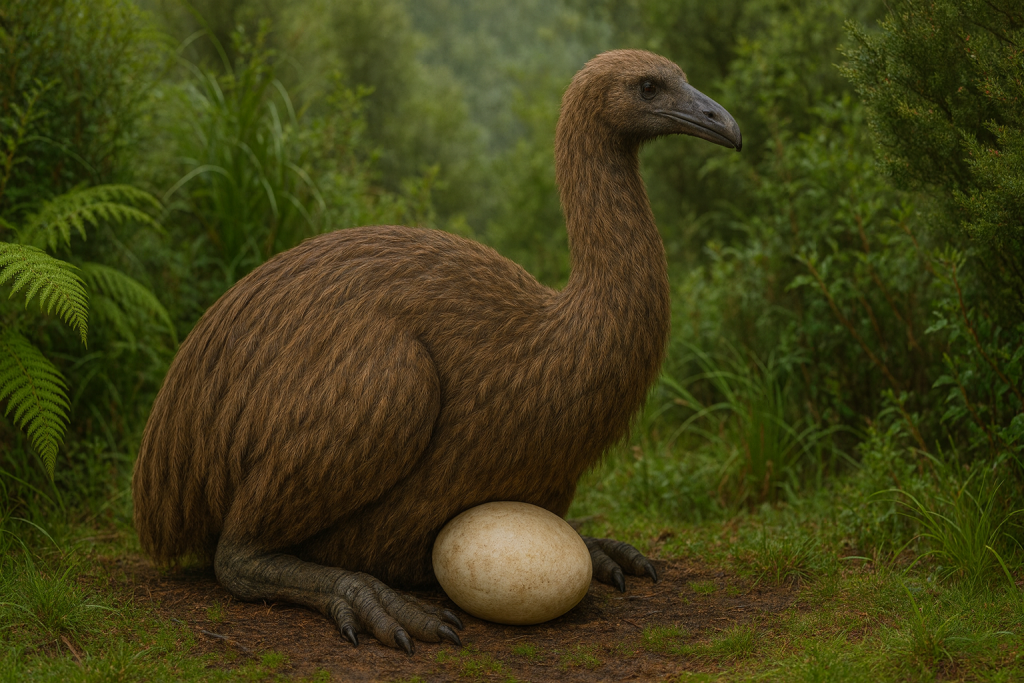
Clutch size in moas was very small. Like other large, long-lived birds, they invested heavily in a few offspring rather than many. One or two eggs per breeding season was probably the norm for most moa species. This aligns with a distant cousin, today’s kiwi that lays a single enormous egg, and ostriches typically lay a clutch but share communal nests. For moas, a clutch of one or two large eggs would have been easier to defend and incubate, especially given their scarcity of natural predators. The thin eggshells also hint that moa embryos required a long incubation, perhaps well over two months before hatching. A protracted incubation would be comparable to the kiwi (70–85 days) or ostrich (~40 days), and is consistent with a slow reproductive cycle. During this period, the incubating parent needed to keep the eggs warm without applying too much pressure. Here, science has revealed an intriguing behavior, It was likely the males, not the enormous females, that did most of the incubating. DNA recovered from the outer surfaces of fossil eggshells often belongs to male individuals, pointing to fathers as the ones who sat on or rather, crouched around the eggs. This pattern mirrors many living ratites. Male ostriches, emus, and kiwis all take on the primary incubation duties. In the case of moas, it made practical sense. Females were often much larger than males, in some species almost three times the male’s weight. A massive female Dinornis could easily have shattered an egg simply by sitting on it. The lighter male, by contrast, could cover the eggs more gently. Scientists speculate that moa fathers may have incubated in a “tenting” posture, possibly curling their bodies or shuffling to periodically turn the eggs without putting full weight on them. The nests’ minimal padding suggests that parents didn’t rely on mounds of vegetation to support their weight, reinforcing the idea that a careful, perhaps novel incubation strategy was at play. Despite these precautions, broken eggshells found at nest sites hint that egg breakage might still have been common, especially for the larger species. Moa eggs, in their ecological context, exemplify a delicate balancing act. Large enough to foster a well-developed chick ready to follow its parents, but thin-shelled enough to demand extraordinary care from the attending father.
Life History and Legacy
The life history of moas was shaped by New Zealand’s predator-free environment and ultimately upended by new predators, including humans. Moas were classic K-selected birds, evolving a strategy of slow reproduction and high investment in each offspring. Once hatched, a moa chick was likely able to run and feed itself quickly, as suggested by the well-developed leg bones in even embryonic moa remains. But it would grow slowly. Studies of moa bone growth rings show that these giants took perhaps up to 10 years to reach adult size, an unusually long youth for a bird. The larger moa species did not grow any faster than the smaller ones. They simply kept growing for more years to attain their gigantic stature. Juvenile moas probably stayed with a parent for some time, learning to forage on the shrubs, ferns, and trees that made up their diet. With few native predators around, a slow-maturing, low-fecundity lifestyle served the moas well for millennia.
Haast’s eagle, a colossal raptor with a three-meter wingspan, was the only significant natural threat to adult moas. This eagle could swoop down and kill even a full-grown giant moa, but such encounters were limited to the eagle’s range in certain forests and valleys. Smaller moa chicks and eggs might have fallen prey to harriers or weka (flightless rails) if left unguarded, but generally New Zealand lacked the mammalian predators, like rodents or pigs, that elsewhere make ground nests so vulnerable.
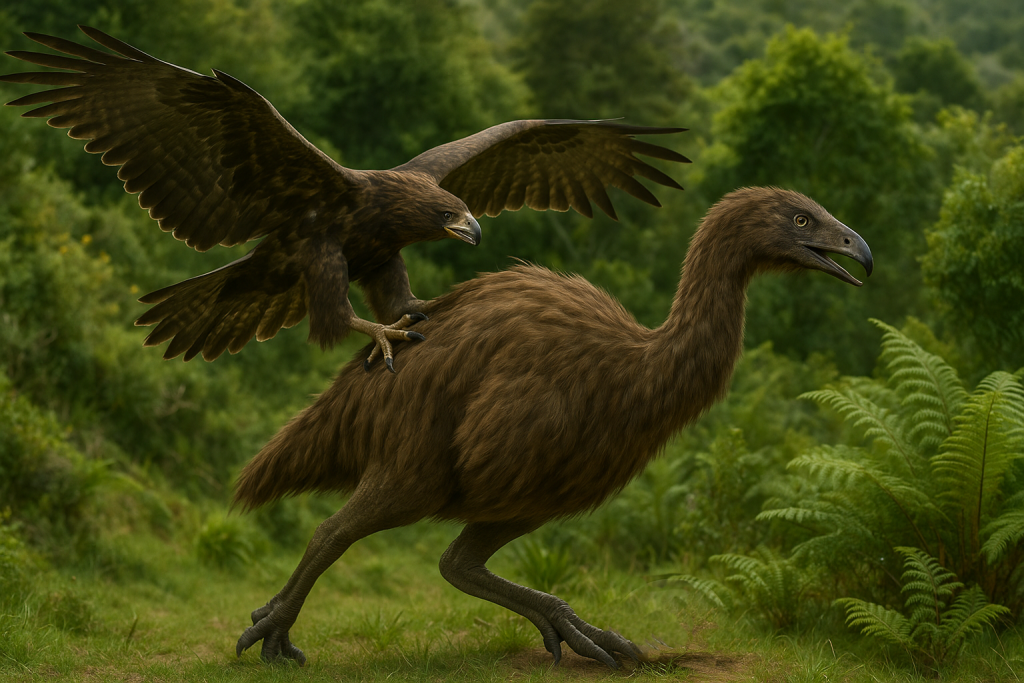
All that changed when humans arrived. Polynesian settlers reached New Zealand around the 1200s, and they came with new animals, notably dogs (kuri) and Pacific rats (kiore). These invaders, along with human hunters, spelled disaster for the moa’s reproductive success. Moa eggs and chicks, never needing special defenses before, suddenly faced a gauntlet of predators. Rats would have eagerly scavenged eggs, gnawing into thin shells to devour the contents. Dogs could easily dispatch unprotected chicks. And humans, armed with fire and tools, targeted the moas themselves. Archaeological sites preserve stark evidence of concentrated remains of tens of thousands of moas in Maori middens. Being large and ground-nesting, the moas were effectively “sitting ducks.” They laid at most a couple of eggs per year and could not replenish their numbers under intense hunting pressure. Within a few short centuries, perhaps in as little as 100 years in some regions, all species of moa were driven to extinction. As the moa vanished, so did Haast’s eagle, its primary predator, collapsing an ancient ecological dynamic.
The demise of the moa is a poignant coda to the story of their eggs. Those enormous eggs, once tended with such care by moa fathers, ended up as tools and trinkets, or refuse cast aside after a meal. Yet they also became messengers through time. Through eggshells, we have sequenced moa DNA and unraveled their family tree. Through eggs in museum collections, we appreciate the astonishing scale and vulnerability of these creatures’ reproduction. And through Māori traditions, we remember the lessons of their loss. In the end, the moa egg embodies the paradox of New Zealand’s lost giants. At once extraordinarily robust, surviving in the ground for centuries to be found by modern eyes, and extraordinarily fragile, unable to withstand the new dangers that civilization brought.
References
- New Zealand Geographic (2005): Brian Gill, Precious eggs. Describes the known moa eggs in collections (33 specimens from 15 sites) and details their sizes, colors, and thin shells.
- Te Ara Encyclopedia of NZ (2009): Trevor Worthy, Moa – Appearance and breeding. Notes a giant moa egg (24 × 17.8 cm) from a Māori grave at Kaikōura, with an opening at one end for use as a water vessel.
- Otago Museum Blog (2023): Allison Miller, A Cracking Good Collection. Confirms that Māori prized moa eggs, hollowing them as water containers and placing them in burials.
- Wikipedia (2025): “Moa” (Dinornithiformes) – Ground-nesting habits inferred from eggshells and nest finds; eggshell characteristics (120–240 mm length range; white or pale green eggs; slit-shaped pores); extremely thin eggshell (~1 mm) in large species and male incubation evidence.
- Australian Geographic (2010): Julian Swallow, Moa fathers looked after fragile eggs. Reports on a PNAS study that found giant moa eggs were “astonishingly fragile” – up to 80× chicken egg volume but thinner shells than any known bird – and that DNA from eggshells indicated male incubation.
- NZ Birds Online (2013, updated 2022): M. Szabo, South Island Giant Moa. Summarizes breeding biology of Dinornis: one or two eggs per season, ~4 kg egg weight, >2 month incubation, male incubation, and spring nesting with twig nest lining.
- Science Learning Hub (2020): Wehi et al., Dead as the moa – oral traditions. Discusses how Māori oral history uses the moa’s extinction in proverbs (e.g. “lost as the moa was lost”) as a cultural metaphor, underscoring the bird’s lasting impact on Māori culture.
- Atlas Obscura (2018): Dan Nosowitz, When the Māori First Settled NZ, They Hunted 500-Pound Birds. Provides a narrative of moa hunting and notes the species’ low reproductive rate – “few eggs (1–2 a year) and long time to maturity” – which made them especially vulnerable to overhunting.
- Journal of Royal Society NZ (2007): B. Gill, Eggshell characteristics of moa eggs. Scientific study of moa eggshell showing thickness varying ~1.0–1.4 mm and generally white to light-buff coloration, with rare green-shelled examples from upland moa.
- PNAS (2010): L. Huynen et al., Ancient DNA reveals extreme egg morphology… in moa. Pioneering research that matched eggshell fragments to species using DNA, confirming that giant moas laid very thin-shelled eggs and likely relied on male-only incubation to avoid breakage.

